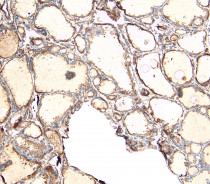ARG63814
anti-ENPP1 / PC1 antibody
anti-ENPP1 / PC1 antibody for IHC-Formalin-fixed paraffin-embedded sections and Human
Cell Biology and Cellular Response antibody; Metabolism antibody; Signaling Transduction antibody
Overview
| Product Description | Goat Polyclonal antibody recognizes ENPP1 / PC1 |
|---|---|
| Tested Reactivity | Hu |
| Predict Reactivity | Ms, Rat |
| Tested Application | IHC-P |
| Host | Goat |
| Clonality | Polyclonal |
| Isotype | IgG |
| Target Name | ENPP1 / PC1 |
| Antigen Species | Human |
| Immunogen | C-KTHLPTFSQED |
| Conjugation | Un-conjugated |
| Alternate Names | Membrane component chromosome 6 surface marker 1; EC 3.6.1.9; Ectonucleotide pyrophosphatase/phosphodiesterase family member 1; NPPase; PDNP1; PC-1; NPPS; NPP1; E-NPP 1; M6S1; Plasma-cell membrane glycoprotein PC-1; EC 3.1.4.1; COLED; PCA1; ARHR2; Phosphodiesterase I/nucleotide pyrophosphatase 1 |
Application Instructions
| Application Suggestion |
|
||||
|---|---|---|---|---|---|
| Application Note | IHC-P: Antigen Retrieval: Heat mediation was performed in Citrate buffer (pH 6.0). * The dilutions indicate recommended starting dilutions and the optimal dilutions or concentrations should be determined by the scientist. |
Properties
| Form | Liquid |
|---|---|
| Purification | Purified from goat serum by antigen affinity chromatography. |
| Buffer | Tris saline (pH 7.3), 0.02% Sodium azide and 0.5% BSA. |
| Preservative | 0.02% Sodium azide |
| Stabilizer | 0.5% BSA |
| Concentration | 0.5 mg/ml |
| Storage Instruction | For continuous use, store undiluted antibody at 2-8°C for up to a week. For long-term storage, aliquot and store at -20°C or below. Storage in frost free freezers is not recommended. Avoid repeated freeze/thaw cycles. Suggest spin the vial prior to opening. The antibody solution should be gently mixed before use. |
| Note | For laboratory research only, not for drug, diagnostic or other use. |
Bioinformation
| Database Links |
Swiss-port # P22413 Human Ectonucleotide pyrophosphatase/phosphodiesterase family member 1 |
|---|---|
| Background | This gene is a member of the ecto-nucleotide pyrophosphatase/phosphodiesterase (ENPP) family. The encoded protein is a type II transmembrane glycoprotein comprising two identical disulfide-bonded subunits. This protein has broad specificity and cleaves a variety of substrates, including phosphodiester bonds of nucleotides and nucleotide sugars and pyrophosphate bonds of nucleotides and nucleotide sugars. This protein may function to hydrolyze nucleoside 5' triphosphates to their corresponding monophosphates and may also hydrolyze diadenosine polyphosphates. Mutations in this gene have been associated with 'idiopathic' infantile arterial calcification, ossification of the posterior longitudinal ligament of the spine (OPLL), and insulin resistance. [provided by RefSeq, Jul 2008] |
| Research Area | Cell Biology and Cellular Response antibody; Metabolism antibody; Signaling Transduction antibody |
| Calculated MW | 105 kDa |
| PTM | Autophosphorylated as part of the catalytic cycle of phosphodiesterase/pyrophosphatase activity. N-glycosylated. A secreted form is produced through cleavage at Lys-103 by intracellular processing. |
Images (1) Click the Picture to Zoom In
-
ARG63814 anti-ENPP1 / PC1 antibody IHC-P image
Immunohistochemistry: Paraffin-embedded Human thyroid gland tissue. Antigen Retrieval: Heat mediation was performed in Citrate buffer (pH 6.0). The tissue section was stained with ARG63814 anti-ENPP1 / PC1 antibody at 8 µg/ml dilution followed by HRP-staining.






